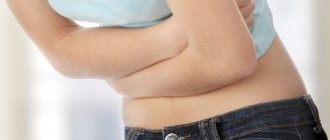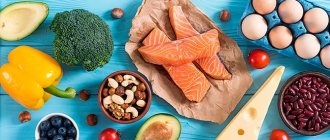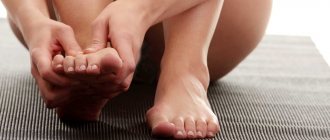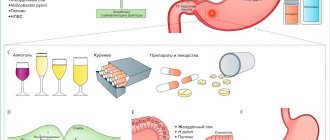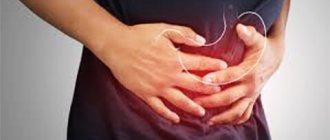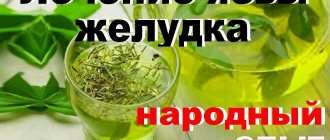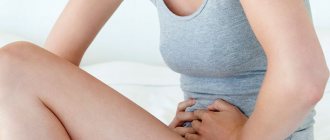Gastroenterologists assign a significant place to dietary nutrition in the treatment of pancreatitis. The pancreas needs to “restart”, and this can only be done by sparing the gastrointestinal tract as much as possible.
Therefore, it is very important to know the nuances of proper organization of the diet and not to consume prohibited foods for pancreatitis.
General rules
The basis of pancreatic disease is an inflammatory process with degenerative changes in the parenchyma of the organ, which in acute pancreatitis can lead to pancreatic necrosis , and in a chronic, often recurrent form - to the development of fibrosis of the parenchyma and sclerosis of the gland tissue. In this case, the digestive function of the gland (mainly proteins) is disrupted, and then the intrasecretory function, in which the insular apparatus is involved in the pathological process, which is manifested by a violation of carbohydrate metabolism and the development of hyperglycemia , glucosuria .
The main symptoms of the disease: nausea, an attack of pain (acute girdling or radiating to the left half of the lower back or chest), general weakness, bloating , diarrhea , vomiting, increased body temperature and, much less frequently, jaundice . Treatment of pancreatitis is complex, the most important component of which is nutritional therapy. Moreover, it is proper therapeutic nutrition that can normalize metabolic processes in the body, including the pancreas, and improve its function.
Diet for pancreatic disease, basic principles
A diet for pancreatic disease should, first of all, be aimed at reducing pain, reducing the secretory function of the pancreas, reducing hyperenzymemia , and restoring impaired metabolic . The basic principles of diet therapy for patients with acute/chronic pancreatitis in the acute stage include:
- hunger and parenteral nutrition with pronounced metabolic and clinical signs of the presence of an autolytic process in the pancreas;
- transferring the patient to a nutritious diet as soon as possible (especially regarding protein levels);
- gradual expansion of the diet by including new foods and dishes in the diet;
- a gradual increase in caloric intake and the volume of the daily diet as the diet expands;
- ensuring maximum protection of the pancreas and gastrointestinal tract from adverse factors.
Along with bed rest and drug treatment in order to reduce the secretion of enzymes of the stomach and pancreas, a patient with acute/chronic pancreatitis in the acute stage is prescribed a 2-3 day fast. During this period, it is allowed to drink non-carbonated Borjomi mineral water at room temperature, 250 ml fractionally 4-5 times - a total of 1-1.5 l/day and rosehip decoction (1-2 glasses).
From the 3rd day, in case of mild pancreatitis, patients are prescribed the pureed (first) version of Diet No. 5P . The diet is low-calorie (1500-1800 Kcal: 60-80 g of proteins (25 g of animal proteins), 50-60 g of fats, 200-300 g of carbohydrates), as gentle as possible, the daily diet includes products that provide the physiological norm of protein with a sharp limitation in diet of fats and easily digestible carbohydrates.
Refractory fats and simple carbohydrates (honey, sugar, confectionery, jam) are limited. Avoid foods that stimulate the secretion of pancreatic juice and contain a lot of fiber.
The menu includes dishes of semi-viscous, liquid and semi-liquid consistency; 50 g white crackers; 5–6 g of table salt: these are cereal soups with a weak vegetable broth or water (slimy or thoroughly pureed), cream soup made from well-cooked meat; steam cutlets, soufflé, quenelles; soft-boiled chicken eggs, egg white omelet (1-2 per week); steam pudding made from fresh cottage cheese; puddings/purees from steamed vegetables (cauliflower, zucchini, potatoes, carrots), pureed porridge with water, jelly, jellies, pureed fresh/dried fruit compotes, mousses with aspartame , fructose , weak tea, rosehip decoction; Butter is added to prepared dishes.
It is prohibited to introduce other foods and dishes into the diet. The drinking regimen for patients is 2 l/day of free fluid. Meals for pancreatic disease are fractional (6–8 times/day), the volume of food consumed in one serving is no more than 300 g.
After 5-10 days, when the exacerbation subsides, the patient is transferred to the untreated (second) version of the 5P Diet , which the patient must follow throughout the entire period of the disease and the transition to the stage of stable clinical remission (3-12 months). Its goal is to prevent relapses and progression of pancreatitis, correcting nutritional disorders that have arisen.
The basis of the diet during the period of subsiding exacerbation and the stage of remission in chronic pancreatitis is an increased content of protein in the diet (110–120 g/day, 60% animal proteins) with a sharp restriction of fats to 60–70 g/day (20% vegetable ), and in some cases (with severe steatorrhea) up to 30–50 g/day and limiting carbohydrates to 300 g/day, mainly mono- and disaccharides, and in cases where diabetes mellitus they are completely excluded.
It is also strictly forbidden to include in the diet foods that stimulate the secretion of digestive juices and are rich in extractive substances. vitamins to the diet of such patients . The amount of table salt is reduced to 6–8 g/day. The energy value of this version of Diet No. 5P is 2500-2700 Kcal.
The menu and range of products in the second version of the diet have been expanded. The diet includes dried wheat bread or crackers up to 200-300 g per day. Vegetable soups with the exception of cabbage and cereal soups (except millet), also with the addition of vermicelli, are allowed. Outside the period of exacerbation, you can add a little sour cream or butter. Meat dishes are prepared from lean varieties of meat or poultry in boiled form (meatballs, cutlets, dumplings, rolls, mashed potatoes), fish dishes from lean river fish in pieces or steamed, boiled, chopped; chicken eggs only in the form of a white omelet; Among fats, it is allowed to consume vegetable oils (olive, sunflower) and unsalted butter.
Dairy products are presented in the diet in the form of homemade non-sour cottage cheese, mild cheese, and fermented milk products. Potatoes, beets, carrots, zucchini, and pumpkin are introduced into the diet as vegetables and dishes made from them. xylitol jelly , weak tea, and a decoction of wheat bran and rose hips are allowed.
treatment with diet for symptoms of severe insufficiency of the exocrine function of the pancreas (syndrome of impaired absorption and digestion, steatorrhea ) with the use of specialized products for dietary nutrition - pureed and homogenized products from veal, beef, chicken meat, beef tongues, vegetables and fruits.
After operations on the pancreas (especially often with a cyst, which is a tumor - a capsule with liquid contents), the passage of contents through the intestines is disrupted, which contributes to the development of dysbiosis and constipation . Signs of malabsorption are often absent. In such cases, the basic Diet 5 for the pancreas is modified. The diet increases the content of vegetables and unsweetened fruits, and reduces the amount of easily digestible carbohydrates to avoid fermentation and flatulence .
For pancreatic lipomatosis Table No. 5 according to Pevzner. Diet for exacerbation and deterioration of the patient’s condition who is in remission - the first version of Table 5P .
At the same time, during an exacerbation, nutrition should be started again with a period of fasting.
Herbal infusions
The menu for treating gastrointestinal problems should include a lot of warm drinks. Regular black tea (not strong and slightly sweetened with honey) is a very good component in a set lunch, breakfast or dinner. But you shouldn’t drink it often.
Herbal infusions bring variety and great benefits to the diet:
- from plantain;
- St. John's wort;
- yarrow;
- rosehip.
Natural medicines soothe inflamed tissues, promote their regeneration, stimulate normal gastric motility and equalize the acid-base balance.
The best way to brew herbs and rose hips is in a thermos. But you can boil the components in a steam bath. Approximate combination of ingredients – 1 tsp. per glass of water.
Varieties
If there are problems with the appearance of clinical signs of diabetes mellitus , diet therapy is adjusted taking into account impaired carbohydrate metabolism, approaching the physiological norm of nutrition as much as possible. In such cases Diet 5P/9 , which excludes in the diet:
- purines (extractive nitrogenous substances);
- foods that promote bloating and fermentation processes in the intestines (cabbage, legumes);
- products formed during the frying process;
- foods rich in lipotropic substances and calcium;
- products containing a lot of essential oils and irritating the mucous membrane of the digestive tract (pepper, onion, garlic);
- salt - up to 6 g per day.
In terms of energy value and nutrient composition, the main diet for diabetes mostly coincides with the 5P Diet , however, the latter is more gentle. In terms of nutritional composition, Diets 5P and 5P/9 are identical. 5-6 meals a day are prescribed, simple carbohydrates are excluded from the diet by increasing the fiber content (bran, pectin), and more than 50% of fats should be vegetable fats. Small meals throughout the day equalize the relationship between blood glucose and insulin .
In the diet, up to 50% of the daily energy requirement should be covered by the carbohydrate portion of the diet. For this purpose, sweeteners are widely used - xylitol , sorbitol , saccharin , aspartame , taking into account individual tolerance.
The diet includes foods containing complex carbohydrates: bread, cereals (excluding semolina and rice); fruits, berries and vegetables that contain less than 5 g of carbohydrates per 100 g of product (cucumbers, zucchini, cauliflower) and vegetables/fruits containing 5-10 g of carbohydrates per 100 g of product (beets, carrots, oranges, tangerines) are limited. The ability of any food to increase blood glucose levels is characterized by the glycemic index . And the lower the index, the more suitable this product is for a patient with diabetes.
There is a special table containing the necessary information, using which the patient can navigate when choosing products. The fat content in the diet of such patients should be less than the physiological norm due to the exclusion of refractory animal fats and foods containing a lot of cholesterol (geese, ducks, pork, liver, lamb, brains, yolks). The 5P/9 diet should contain a sufficient amount of vitamins, especially thiamine (vitamin B1), which is actively involved in carbohydrate metabolism, as well as myco/macroelements.
What is pancreatitis
Pancreatitis is an acute or chronic inflammation of one of the main organs of the endocrine system of our body - the pancreas.
The functioning of the entire gastrointestinal tract and the process of food digestion depend on the normal functioning of this organ. The pancreas is located in close proximity to the liver, right behind the stomach. It performs many functions, the main one of which is the synthesis of hormones, in particular insulin. It also produces digestive enzymes that ensure the breakdown and absorption of fats, proteins and carbohydrates. Digestion of food occurs under the influence of pancreatic juice, which enters directly into the duodenum.
Enzymes and pancreatic juice begin to be produced immediately after any food or drink enters the stomach. Enzymes perform different tasks:
- lipase - breaks down fats;
- lactase, amylase, maltase and invertase convert carbohydrates into monosaccharides - glucose, galactose and fructose;
- trypsin - ensures the body's absorption of proteins.
In essence, pancreatitis is self-poisoning of pancreatic tissue by the enzymes it produces. Inflammation begins with excessive production of certain enzymes in combination with increased pressure in the ducts of the gland. Excess enzymes enter the general bloodstream, negatively affecting the functioning of the brain, kidneys and other internal organs.
Causes of inflammation of the pancreas:
- Alcohol abuse. More than half of the observations (p. 36-47) of pancreatitis are associated with regular consumption of large doses of alcohol.
- Pancreatitis often develops with cholelithiasis, abdominal trauma, the formation of cysts in the bile ducts, and malignant tumors in the gland.
- The disease can be a side effect of taking certain medications, such as diuretics.
The risk group includes diabetics, people with other endocrine pathologies and hepatitis B or C. Sometimes pancreatitis develops during pregnancy or after a kidney transplant.
How does alcohol affect the functioning of the pancreas?
Alcohol breaks down in the body to form acetaldehydes, which are toxic to humans. Pancreatic cells are especially susceptible to their harmful effects. In addition, drinking alcohol can cause spasms and narrowing of the pancreatic ducts, which leads to the accumulation of pancreatic juice in it. As a result, digestive enzymes begin to process the gland itself, causing inflammation. Over time, if the disease is not treated, the cells of the gland die (pancreatic necrosis) and are replaced by scar tissue, the organ loses the ability to function as before.
It is important to understand that the type of drink and its quality do not matter in this case. If a drink contains alcohol, it is harmful. Drinking alcohol together with fatty foods or foods with a high glycemic index can have a particularly negative effect on the functioning of the pancreas, since these products create additional stress on the organ.
Authorized Products
The diet of patients with pancreatitis includes dried bread, unsweetened cookies and white wheat crackers in a total volume of 200-300 g/day, pureed or slimy cereal/vegetable soups with vermicelli, noodles with the addition of butter or sour cream. The diet must include lean meat (rabbit, lean young lamb, beef), boiled or steamed poultry (chicken, turkey), steamed, boiled or baked rabbit (mashed potatoes, cutlets, dumplings, soufflé, roll).
During the period of remission, lean meat, rabbit, and chicken can be served boiled in pieces. Fish dishes are prepared from low-fat varieties of fish (cod, pike, icefish, perch, pike perch, carp) boiled, chopped or in pieces. Chicken eggs are included in the diet in the form of a soft-boiled egg or a steam omelet (up to 2 eggs per day).
It is important to include in the diet dairy dishes and especially non-acidic cottage cheese (preferably homemade), as well as dishes based on it - puddings, casseroles. As side dishes, the diet should include porridge from various cereals and viscous or pureed pasta, vermicelli, homemade noodles, pasta, which is prepared with the addition of milk in a ratio (1:1) or in water.
For vegetable side dishes, beets, carrots, cauliflower, young beans, and boiled, baked or pureed pumpkin are recommended. Fats are mainly unsalted butter and refined vegetable oils, which are added directly to prepared dishes. Sweet dishes in the diet include compotes from pureed fresh and dried fruits, jellies, jelly, mousses from juices with sorbitol or xylitol. Non-carbonated mineral water, rosehip decoction, unsweetened fruit juices, and weak tea with lemon are used as drinks.
Table of permitted products
| Proteins, g | Fats, g | Carbohydrates, g | Calories, kcal | |
Vegetables and greens | ||||
| zucchini | 0,6 | 0,3 | 4,6 | 24 |
| cauliflower | 2,5 | 0,3 | 5,4 | 30 |
| potato | 2,0 | 0,4 | 18,1 | 80 |
| carrot | 1,3 | 0,1 | 6,9 | 32 |
| cucumbers | 0,8 | 0,1 | 2,8 | 15 |
| pumpkin | 1,3 | 0,3 | 7,7 | 28 |
| green beans | 2,0 | 0,2 | 3,6 | 24 |
Fruits | ||||
| apples | 0,4 | 0,4 | 9,8 | 47 |
Cereals and porridges | ||||
| buckwheat (kernel) | 12,6 | 3,3 | 62,1 | 313 |
| semolina | 10,3 | 1,0 | 73,3 | 328 |
| cereals | 11,9 | 7,2 | 69,3 | 366 |
| pearl barley | 9,3 | 1,1 | 73,7 | 320 |
| white rice | 6,7 | 0,7 | 78,9 | 344 |
| barley grits | 10,4 | 1,3 | 66,3 | 324 |
Flour and pasta | ||||
| pasta | 10,4 | 1,1 | 69,7 | 337 |
| noodles | 12,0 | 3,7 | 60,1 | 322 |
Bakery products | ||||
| white bread crackers | 11,2 | 1,4 | 72,2 | 331 |
| wheat bread | 8,1 | 1,0 | 48,8 | 242 |
Confectionery | ||||
| fruit and berry marmalade | 0,4 | 0,0 | 76,6 | 293 |
| paste | 0,5 | 0,0 | 80,8 | 310 |
| Maria cookies | 8,7 | 8,8 | 70,9 | 400 |
Raw materials and seasonings | ||||
| milk sauce | 2,0 | 7,1 | 5,2 | 84 |
Dairy | ||||
| skim milk | 2,0 | 0,1 | 4,8 | 31 |
| kefir | 3,4 | 2,0 | 4,7 | 51 |
| sour cream | 2,8 | 20,0 | 3,2 | 206 |
| curdled milk | 2,9 | 2,5 | 4,1 | 53 |
Cheeses and cottage cheese | ||||
| cottage cheese 1.8% (low-fat) | 18,0 | 1,8 | 3,3 | 101 |
Meat products | ||||
| boiled veal | 30,7 | 0,9 | 0,0 | 131 |
| rabbit | 21,0 | 8,0 | 0,0 | 156 |
Bird | ||||
| boiled chicken breast | 29,8 | 1,8 | 0,5 | 137 |
| boiled turkey fillet | 25,0 | 1,0 | — | 130 |
Eggs | ||||
| chicken eggs | 12,7 | 10,9 | 0,7 | 157 |
Fish and seafood | ||||
| cod | 17,7 | 0,7 | — | 78 |
| hake | 16,6 | 2,2 | 0,0 | 86 |
Oils and fats | ||||
| vegetable oil | 0,0 | 99,0 | 0,0 | 899 |
| butter | 0,5 | 82,5 | 0,8 | 748 |
Juices and compotes | ||||
| juice | 0,3 | 0,1 | 9,2 | 40 |
| rose hip juice | 0,1 | 0,0 | 17,6 | 70 |
| * data is per 100 g of product | ||||
Chemical composition
The rules of gentle nutrition for acute pancreatitis recommend strict adherence to the chemical composition of medical nutrition. The main aspects in this case are the following:
- The daily amount of protein is no more than eighty grams. Moreover, at least half of the total amount is represented by proteins of plant origin.
- The total amount of fat in the first few days after the onset of an acute attack of pancreatitis does not exceed forty grams.
- The predominant element of dietary nutrition for pancreatitis is carbohydrates. During the day, it is recommended to consume them as part of food in quantities of one hundred and fifty to two hundred grams.
- During the first seven to ten days after the onset of an acute attack, it is recommended to completely stop using table salt. In the future, it is permissible to include it in the diet in an amount not exceeding ten grams.
The amount of liquid you drink is not limited by strict standards; you can drink as needed. However, it is important to prevent dehydration by consuming enough water.
Fully or partially limited products
It is prohibited to use soups with meat/mushroom/fish broth in the diet. Excluded are pork, lamb, goose, duck, fried foods, solid refractory animal fats (lard, cooking fats), smoked meats, canned fish/meat, salted and fatty fish, sausages, fresh bread, chum salmon caviar, stellate sturgeon, sturgeon, salmon, catfish, carp, pickles, marinades, spices, mushrooms.
Spicy and fatty snacks, whole milk, strong tea, fatty cottage cheese, coffee, cranberries, cocoa, chocolate, mature legumes, sorrel, spinach, lettuce, radishes, turnips, raw vegetables and fruits are prohibited. Fried or hard-boiled chicken eggs, flour and confectionery products, garlic, sorrel, radishes, green onions, white cabbage, rye bread, carbonated drinks, spinach, cold dishes and drinks, any dough (butter, puff pastry), ice cream, and alcoholic drinks.
Table of prohibited products
| Proteins, g | Fats, g | Carbohydrates, g | Calories, kcal | |
Vegetables and greens | ||||
| vegetables legumes | 9,1 | 1,6 | 27,0 | 168 |
| eggplant | 1,2 | 0,1 | 4,5 | 24 |
| swede | 1,2 | 0,1 | 7,7 | 37 |
| cabbage | 1,8 | 0,1 | 4,7 | 27 |
| sauerkraut | 1,8 | 0,1 | 4,4 | 19 |
| green onion | 1,3 | 0,0 | 4,6 | 19 |
| bulb onions | 1,4 | 0,0 | 10,4 | 41 |
| cucumbers | 0,8 | 0,1 | 2,8 | 15 |
| canned cucumbers | 2,8 | 0,0 | 1,3 | 16 |
| salad pepper | 1,3 | 0,0 | 5,3 | 27 |
| white radish | 1,4 | 0,0 | 4,1 | 21 |
| turnip | 1,5 | 0,1 | 6,2 | 30 |
| canned tomatoes | 1,1 | 0,1 | 3,5 | 20 |
| horseradish | 3,2 | 0,4 | 10,5 | 56 |
| spinach | 2,9 | 0,3 | 2,0 | 22 |
| sorrel | 1,5 | 0,3 | 2,9 | 19 |
Fruits | ||||
| bananas | 1,5 | 0,2 | 21,8 | 95 |
| figs | 0,7 | 0,2 | 13,7 | 49 |
Berries | ||||
| grape | 0,6 | 0,2 | 16,8 | 65 |
| cranberry | 0,5 | 0,0 | 6,8 | 26 |
Mushrooms | ||||
| mushrooms | 3,5 | 2,0 | 2,5 | 30 |
Nuts and dried fruits | ||||
| dates | 2,5 | 0,5 | 69,2 | 274 |
Snacks | ||||
| potato chips | 5,5 | 30,0 | 53,0 | 520 |
Cereals and porridges | ||||
| corn grits | 8,3 | 1,2 | 75,0 | 337 |
| millet cereal | 11,5 | 3,3 | 69,3 | 348 |
Bakery products | ||||
| Rye bread | 6,6 | 1,2 | 34,2 | 165 |
Confectionery | ||||
| jam | 0,3 | 0,2 | 63,0 | 263 |
| jam | 0,3 | 0,1 | 56,0 | 238 |
| candies | 4,3 | 19,8 | 67,5 | 453 |
Ice cream | ||||
| ice cream | 3,7 | 6,9 | 22,1 | 189 |
Cakes | ||||
| cake | 4,4 | 23,4 | 45,2 | 407 |
Chocolate | ||||
| chocolate | 5,4 | 35,3 | 56,5 | 544 |
Raw materials and seasonings | ||||
| mustard | 5,7 | 6,4 | 22,0 | 162 |
| ginger | 1,8 | 0,8 | 15,8 | 80 |
| ketchup | 1,8 | 1,0 | 22,2 | 93 |
| mayonnaise | 2,4 | 67,0 | 3,9 | 627 |
| ground black pepper | 10,4 | 3,3 | 38,7 | 251 |
| chilli | 2,0 | 0,2 | 9,5 | 40 |
Dairy | ||||
| milk 4.5% | 3,1 | 4,5 | 4,7 | 72 |
| cream | 2,8 | 20,0 | 3,7 | 205 |
Meat products | ||||
| pork | 16,0 | 21,6 | 0,0 | 259 |
| salo | 2,4 | 89,0 | 0,0 | 797 |
| beef liver | 17,4 | 3,1 | 0,0 | 98 |
| beef kidneys | 12,5 | 1,8 | 0,0 | 66 |
| beef brains | 9,5 | 9,5 | 0,0 | 124 |
| bacon | 23,0 | 45,0 | 0,0 | 500 |
| ham | 22,6 | 20,9 | 0,0 | 279 |
Sausages | ||||
| dry-cured sausage | 24,1 | 38,3 | 1,0 | 455 |
| sausages | 10,1 | 31,6 | 1,9 | 332 |
| sausages | 12,3 | 25,3 | 0,0 | 277 |
Bird | ||||
| smoked chicken | 27,5 | 8,2 | 0,0 | 184 |
| duck | 16,5 | 61,2 | 0,0 | 346 |
| smoked duck | 19,0 | 28,4 | 0,0 | 337 |
| goose | 16,1 | 33,3 | 0,0 | 364 |
Fish and seafood | ||||
| dried fish | 17,5 | 4,6 | 0,0 | 139 |
| smoked fish | 26,8 | 9,9 | 0,0 | 196 |
| black caviar | 28,0 | 9,7 | 0,0 | 203 |
| salmon caviar granular | 32,0 | 15,0 | 0,0 | 263 |
| salmon | 19,8 | 6,3 | 0,0 | 142 |
| sturgeon | 16,4 | 10,9 | 0,0 | 163 |
| canned fish | 17,5 | 2,0 | 0,0 | 88 |
Oils and fats | ||||
| animal fat | 0,0 | 99,7 | 0,0 | 897 |
| cooking fat | 0,0 | 99,7 | 0,0 | 897 |
Non-alcoholic drinks | ||||
| bread kvass | 0,2 | 0,0 | 5,2 | 27 |
| cola | 0,0 | 0,0 | 10,4 | 42 |
| green tea | 0,0 | 0,0 | 0,0 | — |
| black tea | 20,0 | 5,1 | 6,9 | 152 |
| * data is per 100 g of product | ||||
Menu (power mode)
Since the time period for prescribing the pureed version of the diet is short (3-5 days) and it is prescribed in a hospital, it is more advisable to provide a nutrition menu for the non-mashed (without mechanical sparing) version of the 5P Diet, which should be followed for 6-12 months in case of pain and discomfort. It is necessary to organize split meals 5-6 times a day. For the whole day, the patient is allowed 200 g of wheat bread, 30-40 g of sugar (or 20-30 g of xylitol in sweet dishes) and 20 g of butter.
Monday
| Breakfast |
|
| Lunch |
|
| Dinner |
|
| Afternoon snack |
|
| Dinner |
|
| For the night |
|
Tuesday
| Breakfast |
|
| Lunch |
|
| Dinner |
|
| Afternoon snack |
|
| Dinner |
|
| For the night |
|
Wednesday
| Breakfast |
|
| Lunch |
|
| Dinner |
|
| Afternoon snack |
|
| Dinner |
|
| For the night |
|
Thursday
| Breakfast |
|
| Lunch |
|
| Dinner |
|
| Afternoon snack |
|
| Dinner |
|
| For the night |
|
Friday
| Breakfast |
|
| Lunch |
|
| Dinner |
|
| Afternoon snack |
|
| Dinner |
|
| For the night |
|
Saturday
| Breakfast |
|
| Lunch |
|
| Dinner |
|
| Afternoon snack |
|
| Dinner |
|
| For the night |
|
Sunday
| Breakfast |
|
| Lunch |
|
| Dinner |
|
| Afternoon snack |
|
| Dinner |
|
| For the night |
|
Beverages
In addition to clean water, you can drink mineral water, but without gas. The healing waters of Essentuki, Narzan, Borjomi and other similar drinks, balanced with beneficial minerals, have a positive effect.
Pancreatitis is treated with decoctions of herbs and dried berries or rose hips. Pharmacies offer special pancreatic infusions that are brewed instead of tea.
As for ordinary black tea, weak brewing, it is allowed already on the second or third day after an acute attack. No sugar is added to tea. Instead, you can use a little honey as a bite.
Chicory is considered useful for the diet. It is used instead of coffee and as a medicinal decoction. If the attending physician allows it, drink chicory with milk.
It is not recommended to drink milk in its pure form. Low-fat pasteurized milk is used for milk soups, at first diluted in half with plain water.
You can drink some types of fruit and vegetable juices if the danger of relapse has passed:
- carrot-apple;
- beet-potato;
- apricot;
- pumpkin
An excellent alternative in terms of healthiness and taste are berry and fruit compotes, jelly, and mousses.
Is it possible to drink alcohol if you have pancreatitis?
When asked about alcoholic beverages, gastroenterologists answer unequivocally in the negative. Alcohol is one of the most common causes of pancreatitis.
More than 40 percent of men who regularly drink harmful drinks suffer from inflammation of the pancreas. And drinking alcohol by pregnant women jeopardizes the child’s health and increases the likelihood of pathologies in his pancreas.
Recipes
First meal
Vegetarian soup with zucchini
Vegetables: chop onions and carrots and simmer in a saucepan in water with added oil. Add water and potatoes, cook for 15 minutes. 5 minutes before the potatoes are ready, place the potatoes in the soup, add chopped zucchini, add salt and bring until ready. Sprinkle with herbs on the table and top with sour cream if desired.
Oatmeal soup with cauliflower
Chop carrots and onions in the usual way for soup, simmer in water with vegetable oil. Add water to the volume you need, add chopped potatoes. Boil for 15 minutes, add cauliflower, disassembled into inflorescences, and oat flakes. Cook for 5 minutes. Serve with chopped herbs.
Second courses
Chicken meatballs with mashed potatoes
Wash and cook the rice. Add an egg, rice, a little sautéed onion, and salt to the prepared minced chicken fillet. Knead thoroughly, form meatballs and bake in a mold with sour cream sauce.
Fish quenelles with milk sauce
Beat the fish fillet in a blender. Add wheat bread crumb soaked in milk or semolina. Mix everything and beat again. Gradually add a little cream and whipped egg white, add salt. Use two tablespoons to form quenelles from the dumpling mass, place them on a baking sheet and bake. Can be steamed. Serve with milk sauce.
Dessert
Lapshevnik with cottage cheese
Boil the noodles, add grated cottage cheese, sugar, egg and knead. Place in a suitable pan and bake in the oven until a rough crust forms. Serve with sour cream.
Cheesecakes with carrots and dried apricots
Grate the carrots and simmer with the addition of water and butter. Finely chop the dried apricots, add the grated cottage cheese, add the egg, sour cream, flour, dried apricots and carrots. Form cheesecakes from the curd and carrot mixture and bake them in the oven.
What seasonings can you use?
To diversify the menu, even with pancreatitis, you can use many useful spices. We are talking about the following types of spices:
- turmeric and cloves;
- fennel and cumin;
- sesame;
- Provençal herbs;
- celery;
- parsley and dill (both fresh and dried).
The listed spices can be safely used during remission of chronic pancreatitis or after a few weeks of exacerbation. Garlic, horseradish, vinegar and any type of pepper (peas, crushed, fresh) are strictly prohibited.
Onions cause controversy among nutritionists. Some gastroenterologists argue that these greens are not recommended for pancreatitis. Others allow the addition of onion decoction to soups. If relapses are not observed for more than six months, then a little green onions are allowed in vegetable salads.
Comments from nutritionists
In order to prevent the development of chronic pancreatitis, therapeutic nutrition for pancreatic disease after acute pancreatitis must be observed for 6-12 months until stable clinical remission.
Many “advanced” patients with pancreatitis, trying to find alternative methods of treatment, mainly ask on the Internet whether and how they can treat the disease on their own and whether cleansing the pancreas with folk remedies is effective. Their desire, especially during pain, is understandable. However, it is necessary to warn that the authors of articles on the Internet, where there is a lot of all kinds of advice and recommendations (cleansing with buckwheat, treatment with kvass on celandine, flax seeds, juice therapy, and so on) do not bear any responsibility for them, and you may get an aggravation pancreatitis with all the ensuing consequences. Therefore, it is not recommended to use folk remedies without consulting a gastroenterologist.
Diet for pregnant women
Pregnant women often face problems related to the functioning of the gastrointestinal tract. Pancreatitis can develop due to abuse of vitamin complexes or due to excessive pressure on the pancreas from the uterus.
The principles of the diet for pregnant women do not differ from the general diet for pancreatitis. However, during pregnancy it is extremely important to provide a nutritious diet necessary for the development of the fetus. The following must be present in the food in sufficient quantities:
- proteins (lean meat and fish, dairy products, eggs, legumes),
- complex carbohydrates (cereals, pasta, fruits and vegetables),
- fats (vegetable oils),
- vitamins and minerals.
Reviews and results
For symptoms of pancreatic disease, treatment with diet gives positive results. The diet is gentle and compensates for the necessary protein needs. Meals are prescribed for a long period, and various methods of processing foods (boiling, baking, steaming) allow you to diversify the menu and, according to patients, it is not very boring.
Reviews from patients indicate that dietary nutrition is very important, and some note that they are constantly forced to follow a diet - deviations from it cause a deterioration in their health.
- “... In case of a mild exacerbation, if IVs are not needed, I do not go to the hospital, but carry out the treatment at home and include therapeutic nutrition. I know what to eat and what to exclude, since this is not the first time. The only way out is to give rest to the pancreas and remove broths, fatty and fried foods. The transition to steamed and baked dishes is immediately felt: bloating and discomfort in the left hypochondrium disappear. I tolerate all porridges well, I don’t even exclude boiled vegetables, so the diet is quite complete and not difficult to follow. I try to hold out for a month or two and during this time I also lose weight”;
- “... When my pancreas hurts and mushy stools appear, I switch to this diet. The first time I was in the hospital, they told me to stick with it for at least a year. Dietary restrictions affected my weight, I lost 6 kg. I will be very careful about my nutrition and treatment; in the hospital I was on a very strict diet”;
- “... For problems with the pancreas, the very first thing is diet and regimen. I know that I eat irregularly, often eat fried and fatty foods, which causes aggravation. Moreover, drinking alcohol on holidays has an immediate effect. The doctor warned that you need to constantly follow a diet. It’s difficult for me to stick to it, but what to do if there are frequent exacerbations. Therefore, I decided to endure a year without any disturbances and I can say that during this time I forgot what an exacerbation is and where the pancreas is located”;
- “... When I was in the hospital for the first time with an attack, they told me what the diet for the pancreas should be so as not to burden it and not provoke an exacerbation. Since then, I switched to boiled and baked dishes, introduced my family to them, and I think that this only makes everyone healthier. What is the use of smoked meats and fatty, fried foods? My condition is normal and there have been no exacerbations for 3 years. Of course, sometimes you want to break your diet for a holiday, and this happens, but I allow errors in moderation.”
Rules for eating
It is not enough to know what you can eat; it is important to understand how to do it correctly, otherwise the treatment will be incomplete. So, the diet must meet the following requirements:
- Strictly adhere to the list of permitted and prohibited foods, as well as standards for calories and individual components.
- Maintain a 3-hour break between meals.
- Eat in small portions.
- Try to consume many dietary dishes pureed.
- Eat slowly, chewing as thoroughly as possible.
- Do not drink during or immediately after meals. Wait at least 15 minutes.
- Eat a varied diet, don’t focus on just a few foods.
Separately, it is worth mentioning the duration of the diet. After an exacerbation of the disease, treatment takes on average 2 weeks, sometimes 3. During this period, a person eats especially carefully. With such a disease, nutrition must meet the above criteria throughout life.
